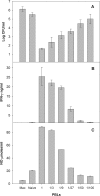Activities of Murine Peripheral Blood Lymphocytes Provide Immune Correlates That Predict Francisella tularensis Vaccine Efficacy
- PMID: 26810039
- PMCID: PMC4807470
- DOI: 10.1128/IAI.01348-15
Activities of Murine Peripheral Blood Lymphocytes Provide Immune Correlates That Predict Francisella tularensis Vaccine Efficacy
Abstract
We previously identified potential correlates of vaccine-induced protection against Francisella tularensis using murine splenocytes and further demonstrated that the relative levels of gene expression varied significantly between tissues. In contrast to splenocytes, peripheral blood leukocytes (PBLs) represent a means to bridge vaccine efficacy in animal models to that in humans. Here we take advantage of this easily accessible source of immune cells to investigate cell-mediated immune responses against tularemia, whose sporadic incidence makes clinical trials of vaccines difficult. Using PBLs from mice vaccinated with F. tularensis Live Vaccine Strain (LVS) and related attenuated strains, we combined the control of in vitro Francisella replication within macrophages with gene expression analyses. The in vitro functions of PBLs, particularly the control of intramacrophage LVS replication, reflected the hierarchy of in vivo protection conferred by LVS-derived vaccines. Moreover, several genes previously identified by the evaluation of splenocytes were also found to be differentially expressed in immune PBLs. In addition, more extensive screening identified additional potential correlates of protection. Finally, expression of selected genes in mouse PBLs obtained shortly after vaccination, without ex vivo restimulation, was different among vaccine groups, suggesting a potential tool to monitor efficacious vaccine-induced immune responses against F. tularensis. Our studies demonstrate that murine PBLs can be used productively to identify potential correlates of protection against F. tularensis and to expand and refine a comprehensive set of protective correlates.
Copyright © 2016, American Society for Microbiology. All Rights Reserved.
Figures






Similar articles
-
Models derived from in vitro analyses of spleen, liver, and lung leukocyte functions predict vaccine efficacy against the Francisella tularensis Live Vaccine Strain (LVS).mBio. 2014 Apr 8;5(2):e00936. doi: 10.1128/mBio.00936-13. mBio. 2014. PMID: 24713322 Free PMC article.
-
A panel of correlates predicts vaccine-induced protection of rats against respiratory challenge with virulent Francisella tularensis.PLoS One. 2018 May 25;13(5):e0198140. doi: 10.1371/journal.pone.0198140. eCollection 2018. PLoS One. 2018. PMID: 29799870 Free PMC article.
-
Francisella tularensis Vaccines Elicit Concurrent Protective T- and B-Cell Immune Responses in BALB/cByJ Mice.PLoS One. 2015 May 14;10(5):e0126570. doi: 10.1371/journal.pone.0126570. eCollection 2015. PLoS One. 2015. PMID: 25973794 Free PMC article.
-
Progress, challenges, and opportunities in Francisella vaccine development.Expert Rev Vaccines. 2016 Sep;15(9):1183-96. doi: 10.1586/14760584.2016.1170601. Epub 2016 May 3. Expert Rev Vaccines. 2016. PMID: 27010448 Review.
-
Vaccination strategies for Francisella tularensis.Adv Drug Deliv Rev. 2005 Jun 17;57(9):1403-14. doi: 10.1016/j.addr.2005.01.030. Adv Drug Deliv Rev. 2005. PMID: 15919131 Review.
Cited by
-
The Many Hosts of Mycobacteria 8 (MHM8): A conference report.Tuberculosis (Edinb). 2020 Mar;121:101914. doi: 10.1016/j.tube.2020.101914. Epub 2020 Feb 11. Tuberculosis (Edinb). 2020. PMID: 32279870 Free PMC article. Review.
-
Current vaccine strategies and novel approaches to combatting Francisella infection.Vaccine. 2024 Apr 2;42(9):2171-2180. doi: 10.1016/j.vaccine.2024.02.086. Epub 2024 Mar 8. Vaccine. 2024. PMID: 38461051 Free PMC article. Review.
-
The O-Ag Antibody Response to Francisella Is Distinct in Rodents and Higher Animals and Can Serve as a Correlate of Protection.Pathogens. 2021 Dec 20;10(12):1646. doi: 10.3390/pathogens10121646. Pathogens. 2021. PMID: 34959601 Free PMC article.
-
Aerosol prime-boost vaccination provides strong protection in outbred rabbits against virulent type A Francisella tularensis.PLoS One. 2018 Oct 22;13(10):e0205928. doi: 10.1371/journal.pone.0205928. eCollection 2018. PLoS One. 2018. PMID: 30346998 Free PMC article.
-
Immune lymphocytes halt replication of Francisella tularensis LVS within the cytoplasm of infected macrophages.Sci Rep. 2020 Jul 21;10(1):12023. doi: 10.1038/s41598-020-68798-2. Sci Rep. 2020. PMID: 32694562 Free PMC article.
References
MeSH terms
Substances
LinkOut - more resources
Full Text Sources
Other Literature Sources

